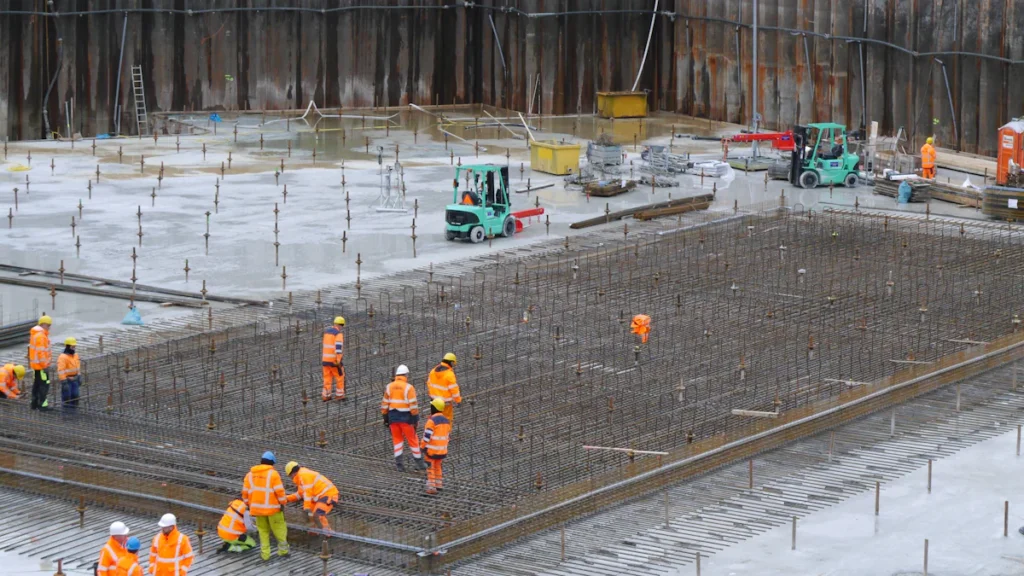
22 Jan Understanding the Basics of Equipment Foundation Concrete
Concrete foundations are crucial for providing a solid equipment foundation concrete that holds heavy machines in place. They ensure that machines remain stable, safe, and operate efficiently. Precise shapes are essential for machines to function properly. Manufacturers specify weight limits to guarantee optimal performance. Steel reinforcement within the equipment foundation concrete helps distribute the machine’s weight evenly. Weak foundations can lead to machines shifting or breaking, resulting in accidents or costly repairs. Strong concrete foundations prevent these issues and are durable over time. Well-constructed foundations protect both machines and workers.
Role of Design Engineers
Design engineers play a big role in building strong foundations. They make sure the foundation can hold the equipment’s weight and movement. The shape and size of the concrete must match the machine’s needs. For example, the pit’s size must fit the machine and the soil’s strength. Engineers also add spaces for controls and pipes, making repairs easier later. Waterproofing is important, especially in wet areas, to stop early damage.
Designing foundations can be tricky. Engineers must solve problems like weak soil or too much water underground. They also need to stay on budget and follow safety rules. Using new materials and methods can be hard but helps make better foundations.
Soil Analysis and Stability
Checking the soil is the first step in planning a foundation. The type of soil decides how much weight it can hold. Some soils, like sand, need deep foundations, while clay might need extra support. Tests help find weak spots or gaps in the soil that could cause problems.
To make the soil stronger, engineers use methods like packing it down or mixing it with lime or cement. Sometimes, they mix different soils to make it stable. These steps help the soil hold the foundation and stop sinking or shaking.
Load Calculations for Foundations
Figuring out the weight a foundation must hold is very important. Engineers check the machine’s weight and movement using data from the maker. They also think about things like wind or earthquakes that could affect the foundation. Wrong calculations can make the foundation too weak or too strong, both of which are bad.
Engineers include spaces for controls and pipes in the design. This helps the foundation support the machine and its needs. Careful planning and correct numbers are key to building strong and lasting foundations.
Waterproofing and Durability Measures
Building strong foundations means keeping water away. Water can harm concrete, causing cracks and damage over time. To stop this, I use ways to block water and make the foundation last longer. One way is adding a waterproof layer on the concrete. This layer stops water from getting inside.
Another way is mixing water-resistant materials into the concrete. These materials help keep moisture out. I also set up drainage systems around the foundation. These systems move water away, stopping it from pooling and causing harm.
Making the foundation strong is just as important. I pick good materials that can handle heavy weights. Adding steel bars or mesh makes the concrete even stronger. This keeps the foundation solid under pressure.
The design of the foundation matters too. A smart design avoids weak spots that might crack. Checking the foundation often helps find small problems early. Fixing them quickly stops bigger issues later.
Using waterproofing, strong materials, and good designs makes long-lasting foundations. These steps protect the concrete and help it work well in any situation.
Construction Techniques for Equipment Foundations

Project Timelines and Scheduling
When planning a foundation, I focus on timing and tasks. Good planning helps the work go smoothly. I make sure tools, workers, and materials are ready on time. Checking progress often helps me fix problems quickly. This keeps the project moving without delays.
I also think about risks like bad weather or broken tools. I make backup plans to handle these issues. Looking at the site and how workers can get there is important too. A clear plan helps finish the foundation on time and ready for use.
Safety Measures During Construction
Safety is very important during building. Everyone must wear safety gear like helmets, gloves, and boots. Before digging, I check for hidden pipes or wires. This step avoids accidents and keeps the area safe.
Tools must be checked before use. Workers are taught how to use them safely. For example, I remind them to keep hands away from moving parts. Following these rules makes the site safer for everyone.
Quality Control in Concrete Construction
Making strong foundations needs good quality checks. I pick strong materials, like special concrete, to avoid cracks. Letting the concrete dry properly makes it stronger. I also mix the right amount of water and cement.
During work, I make sure the concrete is placed and packed well. This stops weak spots from forming. Using good molds keeps the shape correct. Checking the work often helps find and fix problems early. These steps make sure the foundation stays strong for a long time.
Effective Construction Methods
To build strong foundations, I use simple, effective methods. These steps help the foundation hold heavy equipment and last long. First, I prepare the site by clearing dirt and leveling it. A clean, flat surface stops cracks or uneven sinking later.
Next, I place the footings carefully. Footings are the base that spreads the equipment’s weight evenly. I dig deep enough to reach firm soil, especially on sandy ground. Reinforced concrete makes the footings stronger and more reliable.
After the footings, I pour the concrete slab. I mix water, cement, and stones in the right amounts. This makes the slab strong and long-lasting. While pouring, I remove air bubbles and pack the concrete tightly. This step stops weak spots from forming.
Curing the concrete is very important. I keep the slab wet for days so it hardens well. Rushing this step can make the foundation weak. I also check if the slab is level and fits the equipment’s needs.
Finally, I inspect everything before adding the equipment. I look at the footings, slab, and structure for any problems. These steps help me make safe, strong foundations for heavy equipment.
Economic Factors in Equipment Foundation Projects
Cost Drivers in Foundation Construction
I first look at what makes foundation projects expensive. The size and depth of the pit matter a lot. Bigger pits need more materials and workers, raising costs. Weak soil or high water levels also add to expenses. These need extra steps like deep foundations or drains to stay stable.
The type of support system for the soil affects costs too. Retaining walls or sheet piles may be needed to stop soil from falling. Extra pits, like those for scrap conveyors, cost more as well. Adding pipes or bolts increases costs because they need careful placement.
The shape of the concrete also changes the price. Complex designs take more time and effort to build. If the site has low overhead space or no crane access, costs can go up. Limited access slows work and needs special methods. Picking a skilled contractor is important. They plan well and save money by working efficiently.
Balancing Trade-offs Between Cost and Quality
Balancing cost and quality is tricky in these projects. Saving money might seem good but can weaken the foundation. For example, cheap concrete or skipping waterproofing can cause cracks or water damage. These problems make the foundation unsafe and costly to fix later.
I try to save money without lowering quality. New techniques, like robotic digging or prefabrication, cut costs but keep standards high. These methods make work faster and more efficient. Using strong, eco-friendly materials also helps the foundation last longer and protects the environment.
Impact of Site Conditions on Costs and Planning
The site’s condition greatly affects costs and planning. The type of soil decides if shallow or deep foundations are needed. Sandy soil often needs deep foundations to stay strong. High water levels mean adding drains and waterproofing, which cost more.
Overhead space and crane access also matter. Tight spaces need special tools or methods, which can raise costs. I check these things early to make a good plan and budget. Careful planning avoids surprises and keeps the project on track.
Good planning and design are important for strong equipment foundations. A strong foundation keeps machines steady, saves money, and speeds up work. Knowing the machine’s weight, checking the soil, and using good materials are key steps. Engineers, builders, and others must work together. Teamwork helps share ideas, avoid mistakes, and make better choices for the project.
Spending on good foundations gives many benefits over time. It makes machines work better, lowers repair costs, and keeps workers safe. Strong foundations also make workers happier and improve the company’s image. By focusing on quality and teamwork, I make sure foundations stay strong and useful for a long time.


